Pay Up! Launches At Sainsbury's
Holborn, London. Mon 28 May 2012
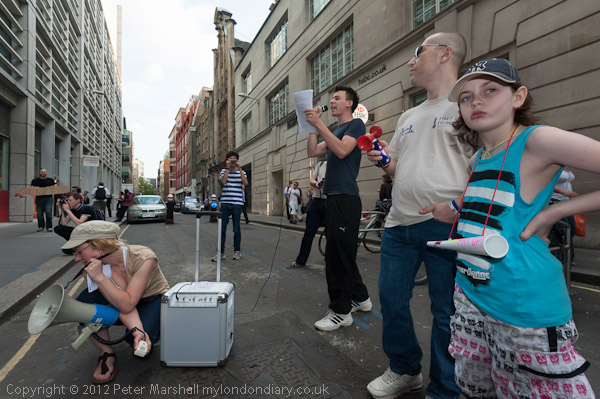 Protesters
outside the Sainbury's shop at Holborn Circus
Protesters
outside the Sainbury's shop at Holborn Circus
more pictures
A new national campaign, Pay Up! launched in London aimed at making poverty a political issue. Its first target was Sainsbury's which despite a 299% increase in profits over the past 7 years still pays thousands of employees below a living wage.
Pay Up! aims to bring together workers on minimum wages with activists from UK Uncut and Occupy, trade unionists, members of community and environmental organisations and others to make poverty a political issue which can no longer be ignored. The hope to generate a public debate around the relationship between labour and capital, to fight and win campaigns to get workers a living wage and to promote workers to become organised and to work with activists from the trade union and civil disobedience movements.
Today's protest was the launch of the Pay Up! movement and also of their first campaign, to get a living wage for the workers at one of our largest supermarket chains, Sainsbury's. Most of the shoppers who go to Sainsbury's are shocked to learn of the low wages it pays to many of its workers, which is very much at odds with the impression that the company likes to promote. You don't hear Sainsbury's boasting that it pays its workers even less than Tesco, but surprisingly Pay Up! says it does, with many on the statutory minimum wage, well below the amount that is needed to live on in London.
Pay Up! point out that the Working Tax Credit by which government tops up the wages of low paid workers to a level at which they can live means that we are actually subsidising the employers who pay rock-bottom wages to an amount thought to be £15 billion.
While we have heard again and again that we have all being living at too high a level for many years and now need austerity measures to pay for this, in fact wages for those at the bottom have largely stagnated for around 30 years - actually decreasing by around 10% in the last 10 years. In contrast the High Pay Commission has reported on the pay of CEOs of leading companies - including bonuses - increasing by 4,000%. They state "Even in 2010, the average CEO pay in the FTSE100 went up by 49%."
Around 30 people met for the protest outside Holborn Station. After a short speech outlining some of the statistics it set up for an undisclosed destination. As it went along High Holborn, some of the many minimum wage employers were pointed out as we passed.
Police were waiting for us at the Sainsbury's Local at Holborn Circus, but despite this around 10 people managed to enter the store for a brief peaceful protest, while police held the others back. After a couple of minutes the protesters walked out of the store and continued the protest on the pavement outside.
A few minutes later, police told the protesters they must move their banner away from the wall of the store, though I could not understand the reason for this. The protesters did very slowly move a little, but not as far as the police wanted, and there were threats of arrest.
The protesters decided they would move around the corner and protest outside
the large block of Sainsbury's training centre on Holborn Circus, where there
were quite a few of Sainsbury's security men standing around. There were some
minor incidents when some of them started pushing protesters who were standing
within the area marked as being owned by Sainsbury's. A couple of protesters
refused to leave until the protest ended around 15 minutes later, having informed
Sainsbury's that this was the start of a nationwide campaign of protests in
Sainsbury's stores which would only end when Sainsbury's paid all of their
staff a living wage.
more pictures
UK Uncut Great British Street Party
Waterloo, Barnes & Putney. Sat 26 May 2012
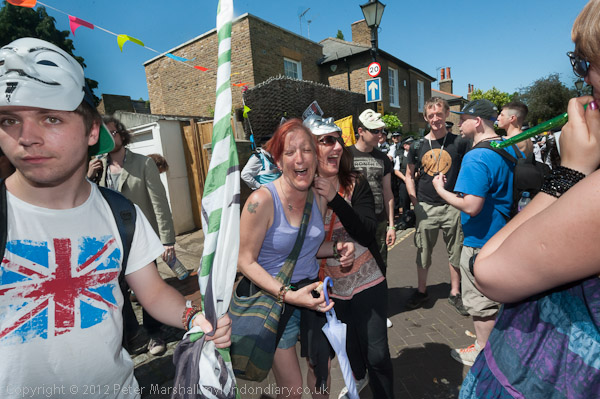
UK Uncut partying in Nick Clegg's Putney Street on a
sunny afternoon
more pictures
UK Uncut celebrated public services which are being destroyed by coalition cuts - the NHS, Welfare State and democracy itself - with a party outside Nick Clegg's large house in a leafy Putney street and called for a better and different future.
UK Uncut's statment said:
"The government is slashing our public services and making the most marginalised people in our society pay for an economic crisis they did nothing to cause. It doesn’t have to be this way. In 1948 the UK’s national debt was far larger than it is today, but instead of cutting services and hitting the poorest hardest the NHS and the Welfare State were born.
So forget the Queen’s Jubilee and join the only London street party worth going to this summer – UK Uncut’s Great London Street Party. Let’s celebrate the services that are being destroyed, take the fight to the streets and party for our future, a different future, a better future, that we can build together."
They organised street parties in a dozen towns and cities across the UK today, with the London event meeting up as 4 blocks, one highlighting the welfare cuts, another the NHS, a third the disproportionate effects the cuts are having on women and the last mourning the effects they are having on democracy itself. The blocks met at four different locations across central London before converging on Waterloo station, where the welfare block, which included a number of wheelchair users and others from Disabled People Against Cuts (DPAC) and some from the Greater London Pensioners Association.
After more than an hour, three or possibly four of the blocks had arrived at Waterloo. Our destination had yet to be revealed, but we got on to a Hounslow train and were told to follow the coloured umbrella for our group - pink for welfare, green for NHS, a yellow UK Uncut flag for women and I didn't see the democracy one, as the groups were to get off at different stations. While more than half the protesters got off at Putney, I stayed on the train with the women and welfare groups until we reached Barnes.
Our destination was still a secret and it was only as we got within a few hundred yards of the short Putney street where Nick Clegg has his London home that we learnt that this was where we would party.
When we arrived at the north end of the street there were just a few protesters, including one in a wheelchair, a couple holding a banner and a handful of police, and as the UK Uncut party-goers (this was a party not a protest!) streamed into the fairly narrow street the police set a line across it, telling us to stop. After a minute or so one or two people decided to try and rush between the police, who turned to grab them, leaving large gaps in the line that the rest of the group could walk or run past, and I went with them.
The larger group of protesters was being held a few yards down the south end of the street by several lines of police, but as we came up behind them they seemed to be at a loss about what to do. After several confused minutes, they reformed a stronger line halfway down the street, leaving the southern end to protesters to hold their party.
There was a samba band playing, and later a very professional group (and another had played earlier at Waterloo) and the sun was shining under a clear blue sky as people sat down to picnic on the street. After an hour or so, someone from UK Uncut made a very short speech about the reasons for being here, and then the partying continued. After a while I decided little further was likely to happen and left.
The Cleggs live in a street of five-bedroom Victorian houses worth around £1.3m, described by estate agents as "one of the most desirable streets" in Putney, a leafy and wealthy suburb a quick and easy commute to Westminster. There were a few neighbours around, but the Cleggs themselves were away. While I was there, although protesters were making themselves at home and sitting or standing on walls, people seemed to be careful to avoid damaging any of the front gardens, even when pushed into them by police. The atmosphere was very much one of a party rather than anything more threatening.
Later I heard that the party had ended around 6pm, with those still present
making their way as a group peacefully to Putney station. On there way there
they were attacked by a group of police, who were perhaps frustrated by not
being allowed to attack the party earlier in the day when the press was present
in large numbers reporting on the event.
more pictures
Hospital Cleaners Protest
St George's Tooting, London. Friday 25 May 2012
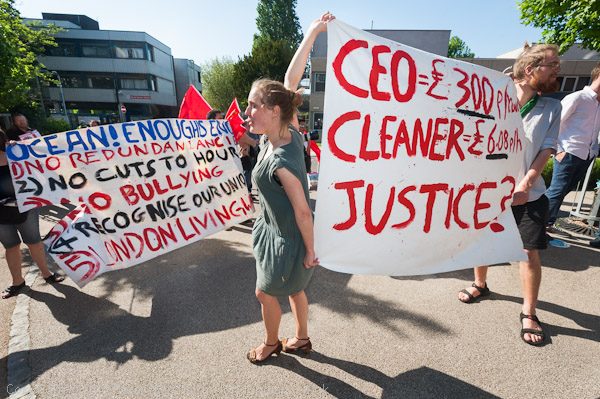
Cleaners want the London Living Wage and no cuts in hours
more pictures
Action by the cleaners at St Georges Hospital - University of London had already resulted in them being promised the London Living Wage from 1 August without redundancies, but a protest planned for today continued against a threat of cuts in hours, which would effectively cut their wages.
Today's protest, attended by a total of around 40 people was held outside the entrance to the hospital in Cranmer Terrace. The hospital authorities came to ask the protesters to move away slightly, but they decided to protest right in front of the main entrance. There were a small number of police in attendance, but the protest although noisy with drums, tambourines, plastic trumpets and vuvuzelas was entirely peaceful and their presence was not required.
Several speakers from the IWW, including Alberto Durango gave short speeches and led the chanting. The cleaners accuse the cleaning contractor Ocean of agreeing to pay the London Living Wage from August 1st but at the same time reducing the number of hours for which they are paid for to do the work, thus effectively cutting their overall pay. Placards and chants contrasted the salaries of the Ocean CEO and the hospital bosses at around £300 and hour with the minimum wage of £6.08 currently paid to cleaners. They also complained about the lack of proper equipment provided for cleaning, including such basic items as gloves for dealing with hazardous waste, and demanded the London Living Wage with no redundancies or reduction in hours, an end to bullying and that Ocean recognise the IWW which represents virtually all of the hospital cleaning staff.
The cleaners were upset by the actions of some other local trade union bureaucrats who have lied and oppposed the stand they have taken for the minimum wage and proper working conditions. The hospital cleaners at St Georges are now almost all members of the IWW, and say that there is only one cleaner still in UNISON, who have a recognition agreement with the cleaning contractor Ocean. The IWW allege that "UNISON have never campaigned for the London Living Wage at St Georges and have actively assisted the management in their efforts to undermine the cleaners resistance to cuts." But other trade unionists, including a Unison activist from Camden and a hospital representative of the UCU came to speak in solidarity.
The cleaners here and elsewhere in London have become dissatisfied by the support they were getting from established trade unions, who they accuse of making deals with employers that neglected them. Many felt that the established trade unions were failing to fully support workers who were on the statutory minimum wage, widely recognised as less than the minimum required to live in London and decided to form a London Cleaners branch of the IWW, the 'Industrial Workers of the World', an international trade union which is not a part of the TUC, and describes itself as a membership led "grassroots and democratic union helping to organise all workers in all workplaces." The IWW was formally registered by the UK government as a trade union in 2006.
Unison, in a letter sent to activists by the local health branch chair, have
claimed responsibility for the progress made by the cleaners, who received
a letter yesterday from the Ocean CEO making the promise on the living wage
from Aug 1st following their leafletting on Wednesday which caused "a
major stir at the University". The Unison letter banned any official
support for the cleaners protest, instructing members not to attend. The letter
also describes the IWW as "a non TUC anti union organisation."
The IWW describes the letter as "a disgrace" and its claims
as "blatant lies."
more pictures
Cookham
Berkshire. Mon 21 May 2012
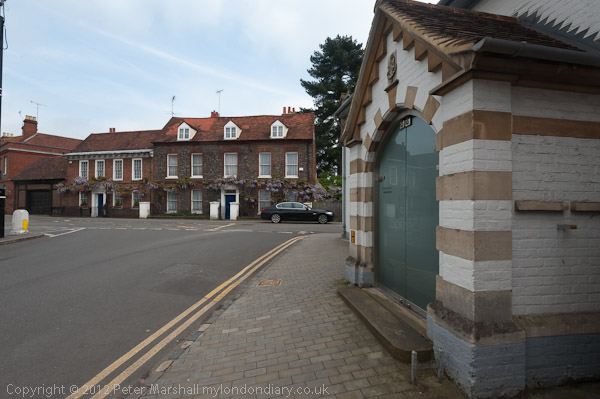
The Methodist Chapel (right) is now the Stanley Spencer
Gallery
more pictures
We went to Cookham to go to the Stanley Spencer Gallery there. I've been several times before and I have usually been - together with my companions - the only visitors and this was the case today. The real attraction for me there is the large unfinished painting 'Christ Preaching at Cookham Regatta' along with a number of his sketches for the work though there are many other fine paintings and drawings, including several currently on loan from the Tate.
Before going into the gallery we had a decent meal at the pub down the road
(nothing is cheap in this area, but it wasn't bad.) Then we took a walk around
the village looking at some of Spencer's favourite haunts. Much of it is rather
disappointing compared with when he knew it, and I didn't take many pictures
more pictures
Council AttemptsTo Rename Staines
Staines, Middlesex. Sun 20 May 2012
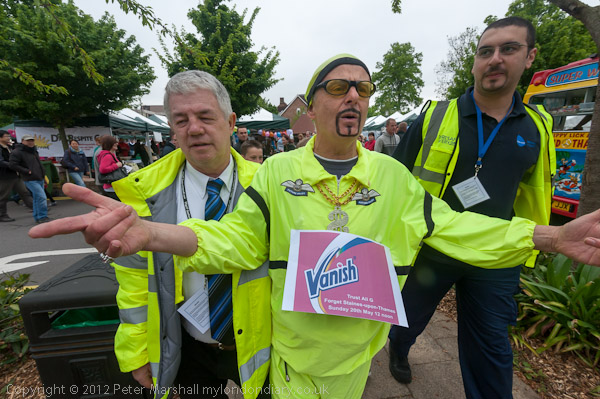
'Ali G' is escorted from the festival site by security
more pictures
An Ali G lookalike who turned up to a Staines event marking the local council's decision to change the name of the town because of the publicity given it by Ali G was escorted off the site by security. It was further proof that some Spelthorne councillors lack a sense of humour but need to make an ass of themselves.
Staines has a long history, a town certainly since Roman times where they built bridges across the various streams of the River Colne and the River Thames, giving it the name Ad Pontes. But by the time of the Domesday book it was known as Staines, and it will certainly continue to be known by that name by those who live there.
But recently some loony local councillors and business people (many of whom actually live outside the town) decided that name was not good enough, and they were going to add '-upon-Thames' (one entirely believable rumour is that the whole thing was the result of a drunken bet.) Opinion in Staines itself was firmly against it, so as usual when official bodies want to ignore the people, the council held a 'consultation'. Only 428 comments in favour were received from a population of around 45,000, but this was greater than the comments against (it helped that they ruled out a number of responses that came via Staines Town, the local football side) and that was good enough for the council.
But of course we will continue to call it Staines even if Spelthorne council has changed its official name. Town names - as one of the proposers of the change noted - apparently have no legal status, and so the document which was signed by various dignitaries at today's ceremony is thus a meaningless paper.
But perhaps today's event will mean that at last Spelthorne Council has developed an interest in Staines and has recognised more fully the potential of its several rivers, rather than simply seeing their banks as a site for car parks. Over the years the council has served Staines badly, selling off or demolishing its more significant buildings and encouraging poor quality office and shopping developments, concentrating its attenion on the leafier parts of the borough.
Perhaps the most encouraging part of the afternoon was the unveiling of the replica of the London Stone first erected over 700 years ago (though parts of it were probably from a Roman altar) to mark the limit of jurisdiction of the City of London over the Thames. Probably in the seventeenth century this was moved from a site adjoining the old Staines bridge to beside the ditch marking the boundary of Middlesex a few hundred yards up river. Around 25 years ago the more ancient parts of the stone were replaced by a replica, and the original is now in Spelthorne Museum. The replica has now been moved back to a much more public site in the Memorial Gardens, probably near to its original site. Spelthorne MP Kwasi Kwarteng introduced the ceremony and the Lord-Lieutenant of Surrey, Dame Sarah Goad, cut the ribbon around the stone.
Another reminder of Staines's past was a display of three finely kept Lagonda sports cars, outside the former town hall, sold off by the council for a bar. The site of the factory that made them is now a supermarket, while the major industry for which Staines had a world-wide reputation - the lino - has gone, making way for a car park and shopping centre.
The one person who has done more to put Staines on the map than anyone in recent years is of course Ali G, with the Staines Town football team adopting him as their unofficial mascot and proudly adopting for themselves the name 'The Massive.'
Ali G has been taken up by those opposed to the name change, with a Facebook page giving 'his' comments:
"Staines is Staines NOT up on Thames. You wanna know 'ow I make diz town bettah? Iz simple, two words: keep it real!
da council Is you on crack or somethin'?
We iz aving da Ali G impersonators convention, dresz up an be ther 'Aaiii'
See da invit pic on mi face book 'Julie Indahouse' yo can mak a poster if ya want
Spelthorne council (da Dictators) are re-naming Staines to Staines-upon-Thames to try to rid itself of the Ali G stigma it thinks it has. Ali G actually put Staines on the map, it does not need a name change for people to know where it is. Therefore to make sure they do not forget Ali G said “Me woz born in da heart off da Staines ghetto... I is head of Da West Staines Massive”
And 'Ali G' (though not his creator Sacha Baron Cohen, but rather the stand up comedian, impersonator and voice-over artist Drew Cameron) did arrive at the event to voice his opposition to the change of name. He walked around the event for around an hour talking to people, many of whom posed to have their pictures taken with him, followed by one of the council staff who he called his bodyguard. I then photographed him being escorted off the site by several of the security staff. He came back on to the site and I took a couple more pictures of him joking with people - most of whom appreciated his presence although one man did suggest that he might get thrown into the river. Apparently he was escorted off the site a second time while I was preparing to photograph what was, apart from a well thought out and delivered speech by Dame Sarah Goad, a rather tedious official ceremony.
Tomorrow we can go back to calling our town Staines again, though doubtless
we will have to put up seeing it referred to by another name on our council's
official documents, including several large name boards beside some of our
roads some of which the council actually managed to put up in the wrong place,
rather annoying some residents of Ashford and Laleham who found themselves
transported. Today was obviously a day when many people were having fun, a
bit of a party and a charity event, though perhaps many like me would have
preferred not to see our council making a laughing stock of itself.
a more pictures
No To NATO, Troops Out Of Afghanistan
US Embassy, London. Sat 19 May 2012
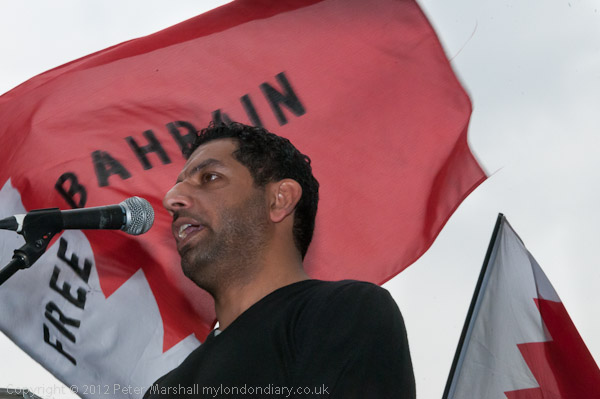
A speaker from Free Bahrain speaks as supporters wave
flags
more pictures
Stop the War and CND held a rally at the US Embassy in London to coincide with the protests at the NATO summit in Chicago calling for an end to the occupation of Afghanistan and a stop to intervention in the Middle East.
The call for 'Troops out of Afghanistan' comes at a time when most observers other than some NATO leaders are clear that the situation has passed crisis point with Afghan soldiers attacking NATO troops, protests against the occupation and a breakdown in negotiations with the Taliban. French troops are expected to be pulled out but the UK and US are committed to remain until 2014.
There are growing threats of military action against Iran, and sanctions have been stepped up, with the International Atomic Energy Agency being used by the US to justify war on Iran and allegations of covert intervention in the country as well as in Syria. Although the US is currently opposed to direct military intervention in Syria, its allies Saudi Arabia and Qatar are sending arms to the Free Syrian Army. Stop the War says it "opposes all military intervention from the west in the region, for which there is absolutely no justification." Previous Stop the War protests have sometimes seen shouting matches between supporters of a free Syria and those backing President al-Assad who is still ordering the army to attack and kill the Syrian people, but neither groups appeared present today, although one stall was displaying a placard in support of the dictator. Stop the War's policy opposing all western intervention has undoubtedly lost them some support among supporters of the Arab spring.
Major protests by the US anti-war movement are expected at the 25th NATO summit hosted by Barack Obama in Chicago on Sunday and Monday 20-21May. A crowd of perhaps three or four hundred made a respectable but hardly impressive protest outside the US Embassy in Grosvenor Square, London. They came from around the country, and included the Campaign against Sanctions and Military Intervention in Iran, those against western support for the Bahraini regime and the Hands Off Somalia Campaign, as well as Palestinian supporters and a few Kurds.
There was a long procession of speakers at the rally and among those listed were Lindsey German of Stop the War, Iraqi exile Sami Ramadani, Sabah Jawad Iraqi Democrats Against Occupation, Mitra Quayoom of Afghans for Peace, Jeremy Corbyn, MP, Palestinian Territories diplomatic representative Manuel Hassassian, GLA member Murad Querishi, Mohammed Sadiq from Justice for Bahrain, Abbas Edalat of the Campaign Against Sanctions and Military Intervention in Iran and Kate Hudson of CND.
I didn't hear all of them as one of the announcements at the event was for an exhibition of paintings by Palestinian students and recent graduates of the An-Najah University on show this weekend at the Arab British Chamber of Commerce just around the corner in Upper Grosvenor Street and I left for a short while to visit this.
There were also messages of support from others including George Galloway,
MP, too busy in his new constituency of Bradford West to attend. The meeting
ended with a powerful speech by former Chair of the Stop the War Coalition
Andrew Murray.
more pictures
Farewell Party for A4e Emma
A4e, Brixton, London. Thu 17 May 2012
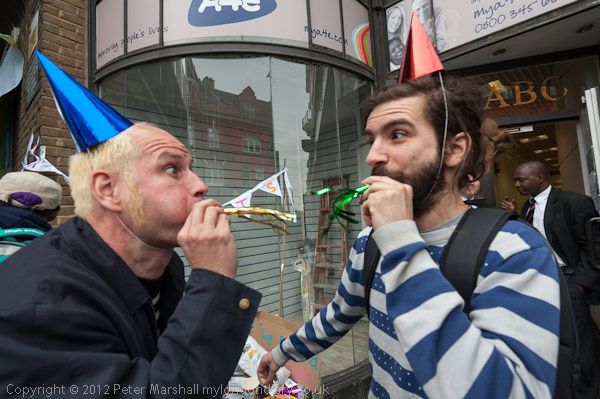 Partying
in protest outside the A4e office on Brixton Rd in the centre of Brixton
Partying
in protest outside the A4e office on Brixton Rd in the centre of Brixton
more pictures
Boycott Workfare protested against workfare with a belated farewell party outside A4e's Brixton office for former Chair Emma Harrison who resigned following allegations of fraud at A4e and disquiet at her £8.6 million from the taxpayer.
In February, Emma Harrison resigned her post as a government adviser and as Chair of A4e, with David Cameron ordering an enquiry in how she was appointed a month after allegations of irregularity in the company, which has contracts for more than £400m from the Government, had been made.
Harrison who was on an annual salary from A4e of £365,000 received a £8.6m shares dividend in 2011, and she and her partner also received £1.7m over two years for leasing properties to the firm.
Protesters - around a dozen when I arrived, but a few more came later - contrasted her generous remuneration - described by the Chair of the Public Accounts Committee as "ripping off the State" - with the £1.60 an hour that benefit claimants who are bullied into unpaid work by A4e receive.
They handed out leaflets on the busy high street outside the A4e offices in Brixton Rd around lunchtime, as well as playing music, collecting signatures for an anti-workfare petition and offering cakes, crisps and biscuits to everyone passing by. Many of those entering and leaving A4e took the leaflets which told claimants of their rights with some interest. Staff from A4e looked on but in the 90 minutes I was present there was no sign of the police, although the protest was only a couple of hundred yards from the police station.
A woman who said she worked for Lambeth council asked the protesters if they had permission for the protest, but permission is not needed for peaceful protest on the public highway, and police may only impose conditions if they believe they are necessary to prevent "serious public disorder, serious damage to property or serious disruption to the life of the community." The protesters were well-behaved, kept on the pavement and left a way clear for the public to walk past so there was no pretext for any intervention.
The protesters pointed out that the Workfare scheme actually cuts down the number of jobs on offer for the unemployed by giving companies such as Asda, Pizza Hut and A4e itself free labour that replaces paid workers. Workfare placements involve the unemployed giving 6 months of their working life to profit the companies and their shareholders.
Boycott Workfare say that their actions have resulted in the '"sanctions" for leaving unpaid work placements on the Work Programme, Work Experience or Sector-based Work Academies' being temporarily suspended. The fact sheet makes clear that the only personal information people need to share with work programme providers is the referral letter and signing on book and that they do not have to give any bank details, proof of identity, CV or other personal details.
Boycott Workfare suggest that if people want work experience they should find something that is really voluntary and that they actually want to do. They also point out that if people are sent on the scheme although they have to turn up on the first day to avoid sanctions, they can leave within the first week without facing sanctions so long as they are not forced to leave for misconduct.
The also make clear that claimants have a right to challenge referral to workfare, and do not have to go on the scheme if they are currently in paid or voluntary work, employment related study or training or have recently taken part in another "employment measure." They should also not be referred because they have a lack of recent work experience or are thought not to have been meeting their jobseeker's agreement.
After an hour and a half there were a few short speeches; some of the protesters
had left and the others were planning to do so shortly as I caught a bus and
made my way home.
more pictures
Ravensbourne
Bromley to Catford, London. Sun 13 May 2012
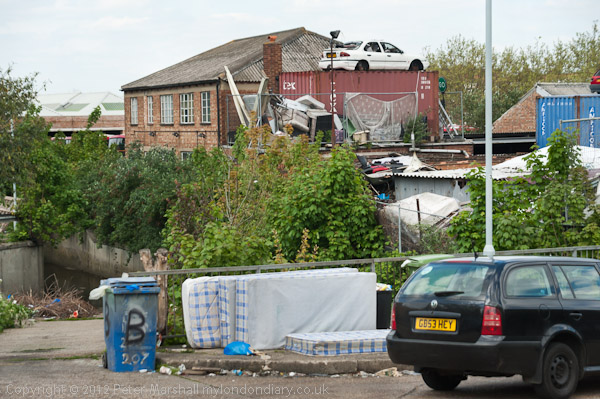
Parts of the river are fairly well hidden, but mainly it is still above ground.
more pictures
I hadn't really meant to go on this walk, but it was a nice day and my other plans had fallen through so it seemed a good idea. But by the time I was approaching Catford I was very hot and tired, and glad to catch the train back to Waterloo East.
It's perhaps a little odd that the main stream of the river which joins this
a quarter of a mile south of Catford is called the Pool
River. I've walked and cycled beside this on previous occasions, as well
as following the river from Catford to the Thames at Deptford Creek.
more pictures
London Crowns 100th May Queen
Hayes, Kent. Sat 12 May 2012
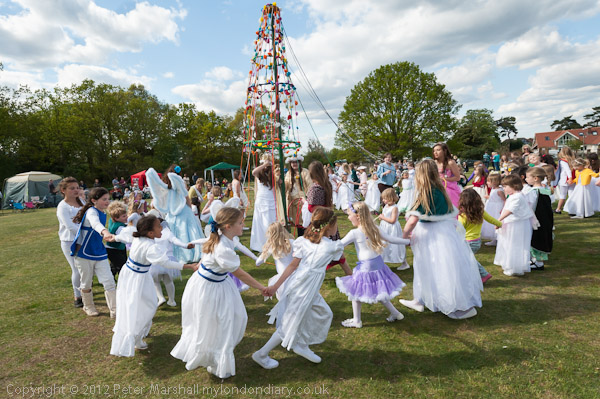
The Merrie England Children Dance around the maypole
with the newly crowned Queen at its centre
more pictures
The 100th London May Queen was crowned at the Merrie England and London May Queen Festival on Hayes Common, Kent, part of an unbroken tradition stretching back to 1913. 20 other Queens and their realms took part.
The Merrie England and London May Queen Festival was started by Joseph Deedy, usually described as a 'Dulwich schoolmaster' in 1913, and moved to its current location on Hayes Common soon after. Surprisingly it continued throughout both world wars, although in a somewhat truncated version, with no procession around the village. It was also felt that holding the ceremony in the open air would present too tempting a target for the enemy, and so it was moved from the common to the parish church. But continue it did, and every year since 1913, one girl has been crowned as the London May Queen, making this year's Festival and Queen the 100th.
Whitelands College in London started its May Queen festival rather earlier in 1881 at the prompting of John Ruskin, and this still continues at the college (now part of the University of Roehampton) although since the college now admits men, some years they have a May King in place of a queen. Talking to one of the organisers of the event yesterday I learnt that Deedy had worked at Whitelands - contrary to the published information on him, including that I retold in my own book on the festival. [You can read a little more about this book - also available much more cheaply as an e-book on >Re:PHOTO. Copies of this and my other Blurb books are usually available to UK addresses more cheaply direct from me.
The ceremonies take place in a large roped off arena on Hayes Common, with the May Queens and their groups from various places on the fringes of south east London taking their places around it in alphabetical order. Each group has its own colour for the dresses and its own flower, and girls who may join as young as three make their way up through the various roles in the group until, if they remain long enough, they become the May Queen of their local realm. After this they can move on to join the London May Queen group, and again take the various roles by seniority until finally - usually when they are around 16 - they become London May Queen. As well as taking part in May Queen activities, May Queens and their groups also appear at various charity events in their local areas.
I arrived just as the procession around Hayes was starting, with the uncrowned queen in a lightweight carriage pulled by Sea Cadets with the Prince of Merrie England walking beside her and preceded by a bagpiper. Behind her were the members of London May Queen, including the Joy Bells celebrating Music, Company, Life, Beauty, Flowers as well as the Fairy Queen, Bo-Peep, Robin Hood and several others.
Behind them came the May Queen realms in alphabetical order - Beckenham, Beddington, Bletchingly, Bromley Common, Caterham, Chislehurst, Coney Hall, Downe, Eden Park, Elmers End, Green St Green, Hayes, Hayes Common, Hayes Village, Orpington, Petts Wood, Shortlands, Wallington, Warlingham and West Wickham. In the heyday of the event in the 1920s and 30s there were as many as 100 groups, and the event made the national newspapers and the cinema newsreels.
At the parish church, the London May Queen group made their way into the churchyard for a short service written by Deedy which he called 'Little Sanctum', before joining back on the end of the procession around the village and back to the common. There the 100th May Queen was crowned and the further pageant witten by Deedy performed, ending with the May Queen being led around the arena by BoPeep and scattering flowers towards the seated May Queen realms. Many of the younger girls were quite tired by the walk around the village and were busy eating ice cream and sandwiches, which revived them considerably, and after the Chislehurst May Queen group had given a demonstration of ribbon dancing, all of the Merrie England children - including a few young boys who mainly take part as pages - came and took part in a lively circle dance around the large maypole.
All that was left was for the May Queen to draw the tickets for the raffle
which helps to cover the expenses.
more pictures
Nakba Day Protest in London
Downing St, London. Sat 12 May 2012
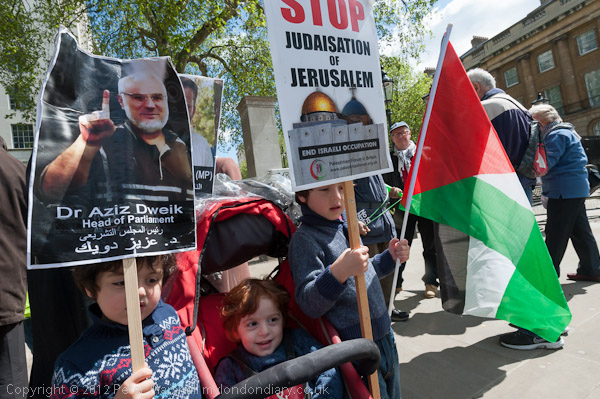
This was a family protest - young protesters hold a Palestinian flag and placards
more pictures
A protest opposite Downing St marked the 64th anniversary of the eviction of around 750,000 Palestinians from their homes by Israel forces in 1948. Nakba Day is generally commemorated on 15 May and the London protest was held on the closest Saturday.
The event was organised by the Palestine Solidarity Campaign, Friends of Al-Aqsa, British Muslim Initiative, Palestinian Forum for Britain, Stop the War Coalition and supported by a wide range of organisations including Architects and Planners for Justice in Palestine (APJP), CAABU, CND, CWU, FBU, Green Party, GUPS UK, Haldane Society of Socialist Lawyers, ICAHD UK, Lawyers for Palestinian Human Rights, Liberal Democrat Friends of Palestine, London BDS, PCS, Viva Palestina, War on Want and Zaytoun.
The protest took place as over 2000 Palestinians in Israeli jails are on hunger strike over 'administrative detention' which allows them to be detained for consequtive periods of up to six months without any charge or trial.
Not only have the displaced Palestinians never been allowed to return to their homes in clear violation of international law, Palestinians are still being removed by the Israeli state. Currently they are planning to forcibly displace around 40,000 Palestinian Bedouin from the Naqab desert, are threatening to demolish the homes of around 85,000 Palestinians in East Jerusalem and to forcibly evict 2,000 from the West Bank.
As UN Special Rapporteur on the Palestinian Territories, Richard Falk, recently said: 'The continued pattern of settlement expansion in East Jerusalem combined with forcible eviction of long residing Palestinians are creating an intolerable situation that can only be described, in its cumulative impact, as a form of ethnic cleansing’.
Unfortunately I had to leave as the event was starting as I had promised
to photograph another event.
more pictures
Morris Men Occupy Westminster
Westminster, London. Sat 12 May 2012
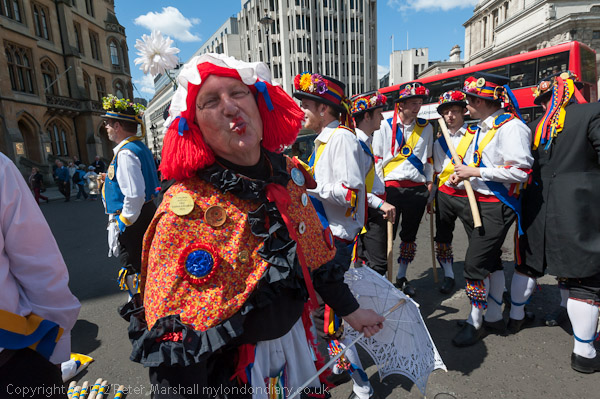
A Morris dancer dressed as a woman, who plays the fool, blows me a kiss
more pictures
Pavements across Westminster were filled with gaily dressed men with bells on them leaping and dancing as twelve Morris sides performed in around twenty sets over the day in Central London on the Westminster Day of Dance.
The dancing had begun at 10.15am, with the Morris Men performing in four groups on the Victoria Embankment, St Margarets Westminster, Westminster Cathedral and Tate Britain. After a half hour performance each group then rushed (perhaps with a brief call at a pub) to the next four locations, and I watched the dancers on the wide pavement area where Agar St meets The Strand. Many of those passing by - mainly tourists on their way to or from Covent Garden - stopped for a few minutes to watch.
For the final morning session I made my way to The Sanctuary, an open area at the west of Westminster Abbey with the tall red granite column rising from its centre erected in memory of old boys of Westminster School to its south who died in the Crimean War and Indian Mutiny. The area around its base with a low chain around it made a convenient place for the dancers to leave their kit while they danced on the yard between the column and the abbey.
One group of dancers was announced by the MC as being more like hooligans, and when we saw the energy with which they clashed their sticks together we could understand why. Several slivers of wood went flying and hit at least one person in the crowd, and a couple of times sticks were knocked out of a dancer's hands, and one of the roughly 3 or 4 cm diameter sticks was broken. It would however have perhaps been fairer to compare the activity to military exercise.
As well as the highly disciplined dancing and sometimes very energetic dancing to the sounds of the melodeon, fiddle and other folk instruments, Morris also includes other elements from its tradition of misrule. Many tourists watching were suprised to find their legs being tickled from behind with a feather duster or a large prancing horse placing its hand on their shoulder.
I left as the morning sessions ended and the Morris Men had a break for a
doubtless mainly liquid lunch (dancing really is thirsty work) before the
afternoon sessions which, after a euphemistically named 'Tea Break' were to
conclude with a mass performance south of the river by the National Theatre.
more pictures
Punch Celebrates 350th Birthday
Covent Garden, London. Sat 12 May 2010
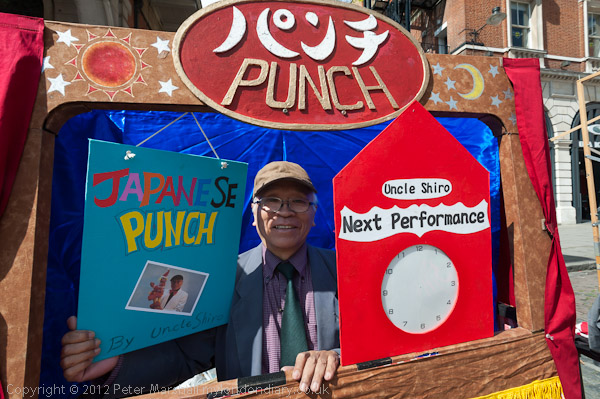
Professors had come from around the world including
Uncle Shiro the only Japanese Punch
more pictures
Punch and Judy professors from around the country and around the world brought their booths to Covent Garden this weekend to celebrate 350 years since Samuel Pepys first recorded a performance there in his diary.
In his diary entry for 9 May 1662 Pepys wrote that he had been to Covent Garden and seen "an Italian puppet play, that is within the rails there, which is very pretty." At the time the character who later became Punch was called Pulcinella, but otherwise was very similar. Although the play had probably been playing earlier - perhaps since the restoration of the monarchy in 1660 as the Puritans would certainly not have approved - this is the first record and it is celebrated as the birth of Punch.
When I arrived at Covent Garden there were around a dozen booths being set up in the square in front of St Paul's Church, on each side of a large platform, and a small crowd including a number of Punch and Judy performers, many holding their Punch. The celebrations were to go on over both Saturday and Sunday, and later the garden with more booths would be open to tbe public. There has been a smaller annual Punch & Judy fair held annually in the churchyard for some years.
Included in the booths in the square were several from foreign Professors, including one flying two Austrialian flags and with an impressive coat of arms including a kangaroo as well as a curtain across it's 'stage' with an impresionistic depiction of the Sydney opera house and bridge. Close to it was the booth of Uncle Shiro, Japan's only Punch & Judy man. The Japanese Mr Punch looks a little different from current British ones, but his behaviour seems very much the same.
At 11am, the first show began, with mats being thrown onto the cobbles for
some of the children to sit on and adults standing behind to groan at the
jokes of the Professor Geoff Felix, who who then went into his booth to start
with a boxing match and then go on to the story of Punch & Judy.
more pictures
4000 Days in Parliament Square
Parliament Square Peace Campaign, London. Thu 10 May 2012
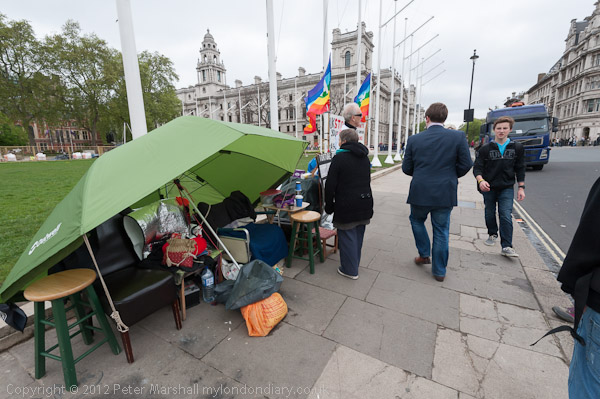
The only shelter allowed is an umbrella - which will
probably soon be stolen by police and council
more pictures
As I put these few images on line on Tuesday 15 May, the Parliament Square Peace Campaign begun by Brian Haw on the 2nd June 2001 has been there protesting 24 hours a day for four thousand days and nights.
They remain there making their protest despite constant harassment over the almost 11 years by police, driven by politicians, who have passed two Acts of Parliament aimed at removing them. Brian's protest, following his death from cancer, has been continued by Barbara Tucker and other supporters who have maintained the protest on those various occasions when Brian or Barbara was arrested and held overnight.
A few hours before I arrived, police had come and spent 90 minutes "searching" the few square meters of their display in the early morning, and three days later, at 2.30am on Sunday 13 May, police and Westminster Council came and took away the two blankets that Barbara Tucker, no longer allowed to have any "structure designed solely or mainly to sleep in" by law was using to survive in the open. This was apparently one of two visits over the weekend by police and council in which they illegally removed property from the site.
Doubtless the attempts to remove the protest by any means will increase over
the next few weeks as a part of a city-wide attempt to "clean up"
London for the Olympics which has already seen orders banning Newham's teenagers
from going to Stratford and various raids on East Europeans around Marble
Arch and moves elsewhere in London against street sleepers and others.
more pictures
Public Sector Pensions Strike and March
St Thomas' Hospital - Central Hall, London. Thu 10 May 2012
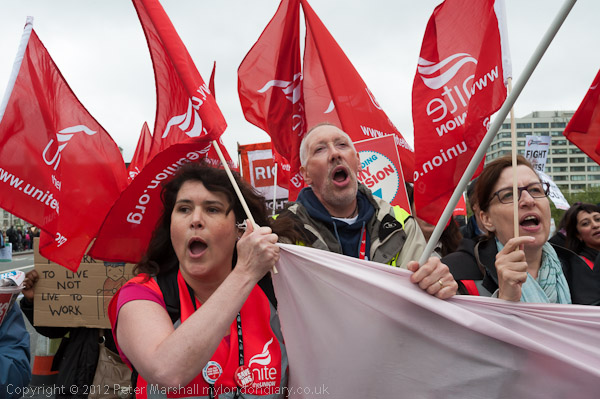
Marchers hold the banner and carry Unite flags from
St Thomas' (top right) to a union rally
more pictures
Public sector workers in Unite, PCS and UCU on strike against cuts in pensions, jobs and services picketed workplaces and marched from a rally at St Thomas' Hospital across Westminster Bridge to Methodist Central Hall for a further rally.
The day began early for many trade unionists with picket line outside places of work in the early hours of the morning. Some started at 5am, and most were in place by 8am. The PCS picket at Tate Britain was still outside several hours later when I arrived, and I found another picket outside the House of Commons as I was on my way to photograph the march leading from a rally outside St Thomas' Hospital on the opposite bank of the Thames.
The march of around a thousand people which had followed a rally there, was just leaving as I arrived and I rushed to photograph it as it walked the short distance across Westminster Bridge. The banner at its front was for solidarity with the Greek Strikes and Occupations, in the lead in the opposition to austerity. Many of the marchers carried Unite flags, but others had placards from the Right to Work campaign calling for and end to austerity or Socialist Workers placards calling for Cameron to go and for a national strike, with others carrying Unite placards against the pensions theft.
Many workers are not surprising incensed by the increases in pension contributions, and further increases are planned. Civil service retirement is linked to the state pension age, meaning that it will soon be 68, and the government has said it will go higher. As they marched, people were chanting "Sixty-eight - is TOO Late". Pensioners also feel they are being cheated by the government's decision to index them to the CPI inflation rather than the higher RPI inflation figures, which will mean them receiving some 15-20% less. Over 94% of Unite's NHS members voted to reject the government's proposals and take strike action today along with members from the Ministry of Defence and government departments as well as others from the PCS and UCU
The march ended at Methodist Central Hall, where the unions were holding
a rally at 1pm. Some people from the march instead protested demanding the
freedom to protest against the Police Federation March which started to make
its way past soon after the pensions march ended.
more pictures
Police March Against Cuts and Winsor
Westminster, London. Thu 10 May 2012
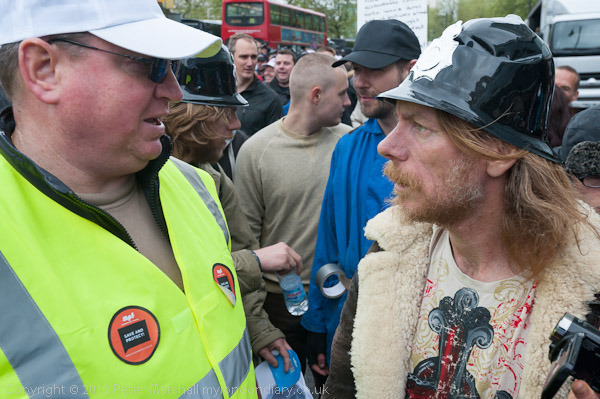
A police officer questions Occupy supporter about their
presence on the police march
more pictures
An estimated 20,000 police from all 43 forces in England & Wales marched through central London in protest at 20% cuts in police budget and proposed restructuring following the Winsor review. Occupy, Right To Protest and others joined in to protest for justice in policing.
The Police are not allowed to strike or belong to a proper trade union, but the Police Federation is able to organise demonstrations like that today when thousands of off-duty police, some with family members made a impressively large if rather dull protest past the Home Office, the Houses of Parliament and Downing St. Most of them were wearing black caps, and there were 16,000 of these, the number of warranted officers expected to be lost over the next four years due to the cut in the police budget of 20-30%.
Like other public sector workers, police have had their pay frozen for two years, and for some at least the amount of overtime has dropped dramatically. Like others in the public sector who were on strike today the police are also seeing increases in pension contributions.
As police are not allowed to strike, there were some police who would have liked to join the protest but who had to work today, and some were involved in policing the police protest. A few police on the protest carried small posters with the names of officers who had been unable to attend due to being at work.
This was a protest in which very few people carried placards or banners and in which there was little or no chanting, just most of the time people walking along the street chatting with their neighbours. There were a number wearing shirts with messages on them, some just repeating the message of the main banner, 'Cutting Police by 20% is criminal' but others more creative. Popular was one with a picture of Home Secretary Teresa May and the text 'Get Shafted and Carry On', while there were those showing a picture of a warrant card on the front with message 'Her Majesty Gave Me This' with the back showing a knife stabbing and blood dripping with 'May and Winsor gave me this'.
As at the previous police protest in 2008, the Space Hijackers weree present with a 'professional protest stall' and were prepared to offer advice on making placards and chanting. In 2008 there was considerable anger from many of the police directed at these protesters, but this time most of the marchers seemed to be amused, particularly by their chants of 'One Solution - Institution' and some of the mock placards, although there were a few jeers. One of the police on duty threated the protesters with arrest if they continued to display one of their placards which contained the letters ACAB (as in the popular refrain "I'll sing you a song and it won't take long ... and often tatooed between the fingers of prisoners as well as the title of a punk song.)
Much of the time police stood between the stall and the marchers, watching the stall, though this seemed simply to be an attempt at intimidation of the protesters who given they were outnumbered by several thousand to one were rather unlikely to cause any trouble. Police used the same tactic in front of a group of protesters with the 'Defend the Right to Protest' banner, who were shouting slogans against police violence including 'Who kills the youth? Police kills the youth!' and 'Mark Duggan! - Never Again!' and the unfortunately large number of possible variations on the theme of deaths at the hands of police. Rather lighter in tone - and certainly I saw some of the police grinning - was there 'No Justice No Peace - Kettle the Police!'
At the start of the protest their had been a few slightly tense exchanges when a small group of people from Occupy London came to join in the protest. One carried a placard with the excessively long message (which I reproduce uncorrected):
WHAT DO WE WANT?
"A fully, Publicly funded, democraticly accountabe Police force who's aims and objectives enshrine the right to peaceful Protest in some sort of People's Charter!
When Do We Want it?
NOW!
They had brought plastic police helmets which they put on and they joined in with the march, making clear that they were not against the police but that they wanted a police force that worked for the 99% and not for the 1%.
A number of others also took advantage of the march to publicise various
other matters related to the police, including Ian Puddick who got intimidated,
attacked and prosecuted by City of London Terrorism Police and Counter Terrorism
Directorate in an operation costing millions carried out on behalf of a giant
US security corporation after he discovered his wife had been having an affair
with one of her bosses. Like almost all other cases involving police corruption
there will probably never be a proper enquiry into the affair. Puddick who
has been exonerated by the courts over the action he took marched with a prominent
sign 'Police Corruption' including the address of his web site, and there
was another man with an identical placard walking a few yards ahead of the
police protest as it camed into Parliament Square.
more pictures
Save Jeju, Island Of World Peace
Buckingham Gate, London. Wed 9 May 2012
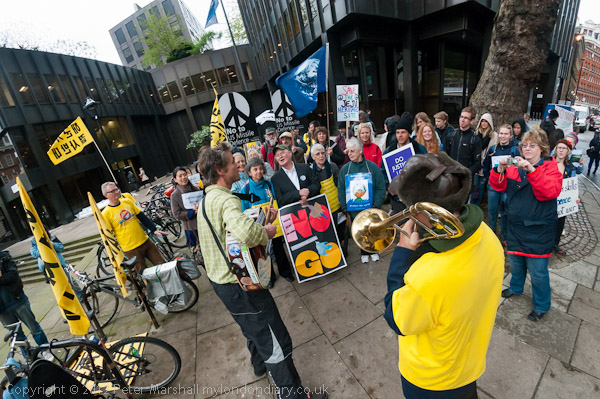
Musicians improvise a protest song with the crowd
more pictures
A protest at the Korean Embassy demanded a halt to the building of a naval base for US ballistic missiles aimed at China at Ganjeong on Jeju Island, a fishing village in one of the ''New7Wonders of Nature' designated as the 'Island of World Peace'.
There were more than 70 protesters on Brewer's Green facing the South Korean embassy with banners and placards, singing enthusiastically to the leading of a guitarist and trombone player who had the crowd making up songs calling for human rights in Korea and an end to the building of a large military base for Korean and US warships in the small fishing village of Gangjeong on Jeju Island.
As well as a number of Koreans, the protest also include a number of religious and other peace groups including Pax Christi, London Catholic Workers, CND and the Campaign for the Accountability of American Bases. Many of those present signed a letter which was taken into the Korean Embassy calling for the plans for the base to be abandoned and the repression of the villagers to stop.
Kate Hudson of CND spoke about the dangers of the military arms race of which the US ballistic missile system which would be targeted on China from the ships using the base. A message from Mayor Kang Dong-Kyun of Gangjeong was read out, in which he said "The peace of the world starts from Gangjeong and we believe that it also starts wherever there is solidarity with Gangjeong." The London protest was one of a number taking place around the world today, and others have already taken place elsewhere.
Samsung is a major partner in the building of the base, and there was a call for everyone to boycott Samsung products as a way to put pressure on the South Korean government to halt the building of the base.
Jeju Island off the coast of South Korea was named as the 'Island of World Peace' by the late South Korean President Roh Moo-hyun. An island around the size of a middling English county such as Warwickshire or Worcestershire, it has more UNESCO World Natural Heritage sites than any other single location and is designated as a Global Biosphere Reserve. Recently it was one of the first four world-wide winners to be declared in the 'New7Wonders of Nature' global initiative. But the Korean government plans to build a naval base there at the village of Gangjeong, to serve as a base for US guided missile-equipped Aegis Destroyers, submarines and aircraft carriers, a part of the US ballistic missile defence system targeted at China.
The village is surrounded by three UNESCO World Natural Heritage sites and nine UNESCO Geo-Parks. 94% of the residents of this small fishing village have voted against the military base and many have been arrested or assaulted during non-violent protests against the development. As many as 1500 Korean police and security forces have been deployed against the 1900 residents of Ganjeong. The Mayor of Gangjeong along with many others has been jailed and South Korea's foremost film critic Yang Yoon-Moo attracted national and international attention with a 71-day hunger strike. Among those who has become involved is actor and director Robert Redford, and the protests have been covered by the press and broadcasters world-wide, including Al-Jazeera.
On January 16 this year the Asian Human Rights Commission issued a statement urging "the government of South Korea to stop the arbitrary use of force by the police and military in Gangjeong village in Jeju Island, guarantee the right to peaceful assembly and demonstration and respond to the demand of villagers who are affected by the construction."
Jeju because of its island location has always been rather separate from
mainland Korea, and in 2006 was madethe first and only special autonmous province
of South Korea. In 1948, before the Korean War, the South Korean police and
military under the support of the US military mandate put down an independence
movement they called the Jeju Uprising with a scorched earth policy. Over
30,000 of the inhabitants (around a ninth of the population at the time, although
it has grown considerably since to over 500,000) were killed, and many tortured,
raped and interned and nine-tenths of villages burnt to the ground in "anti-communist"
act of genocide.
more pictures
Grand Union Ride
West Drayton - Rickmansworth. Mon 7 May 2012
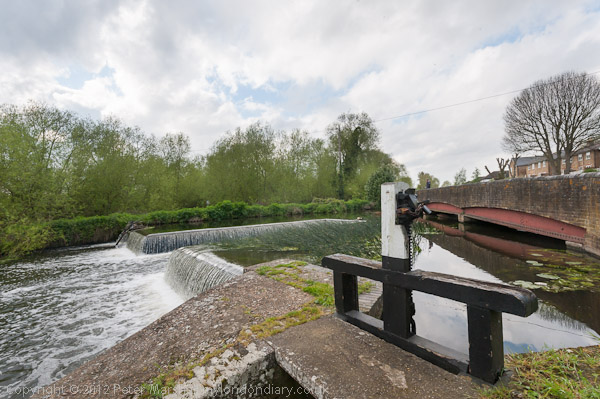
Parts of the canal are also the River Colne, which leaves
it over this weir
more pictures
Surprisingly the rain stopped and sun came out after lunch on the bank holiday, and in mid-afternoon we decided to go for a bike ride. We rode past Terminal 5 and then through Harmondsworth to the Grand Union canal at West Drayton, then along it as far as Rickmansworth. There were a few sections where the mud more or less brought the Brompton to a halt, filling up between tyre and mudguard; I managed to keep going, but it was like riding up a steep hill on the flat. Otherwise it was pretty easy going, though a bit bumpy. I didn't stop to take many pictures, partly because I've photographed along here quite a lot in the past.
Coming home we took the same route along the canal, leaving it just a little further east and skirted around Harmondsworth to go down through what remains of Longford, on the north-western fringe of Heathrow. The traffic on the road to the west of the airport is tedious with many fast moving lorries and no cycle path until you get south of Stanwell Moor - and most of the path there is in very poor condition, making cycling on it rather unpleasant, though I do as the road is so narrow and dangerous.
I've done little cycling in the past year other than for local shopping,
and although we only did around 30 miles I was exhausted by the time we got
home. I've cycled this way (and further) many times in the past without getting
anything like so tired.
more pictures
Climate Impacts Day - London
St Pauls and Globe Theatre, London. Sat 5 May 2012
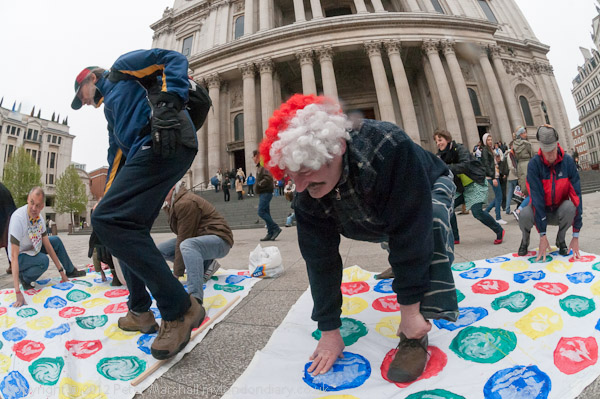
Playing the Climate Twister game outside St Paul's Cathedral
more pictures
An event outside St Paul's Cathedral with Occupy London and international climate campaign 350.org on 'Climate Impacts Day' was part of a worldwide event to 'connect the dots', connecting the evidence of weather disasters with global warming.
This was advertised as a 'fun day', but one with a deeply serious purpose, aiming to mobilise public support for the urgent action by governments around the world needed to avert climate disaster. The campaign points out the increasing prevalence of extreme climate effects we are already seeing - including perhaps our own minor problems with drought and a record rainfall last month. 350.org takes its name from what it considers as the maximum sustainable level of carbon dioxide in the atmosphere - 350ppm, well below the current level of 394ppmn
Around the world we have seen many much more serious events - the Russian heatwave in 2010 which killed 55,000 and cost $15 billion, the famine in the Horn of Africa when rainy seasons failed in 2010 and 2011, the same year there were unusual monsoon rains in Thailand the killed 600 and cost the country 18% of its GDP. In 2010, Pakistan both suffered from the hottest temperature ever recorded in Asia - 53.5 C / 128.3 F and the floods which were the most expensive natural disaster in the nation’s history causing $9.5 billion in damage and displacing 20 million people.
The event at St Paul's was organised by Occupy London's Energy, Equity and Environment Group together with 350.org and also included International Stop the Tar Sands Day (ISTSDay), against the excessive climate impact of newer fossil-fuel energy sources including tar sands, oil shale and fracking for gas.
The day started with playing the 'Giant Twister' game on large sheets marked with coloured circles for fire (red), flood Blue), tornado (green) and drought (yellow). A spinner was used to select a combination of limb and colour which each player had to adopt, such as putting their left hand on a red symbol, while keeping their other hand and legs on the previously selected circles, sometimes resulting in some interesting contortions. With each selection came the reading of a climate change-related fact - such as:
'In 2010, the Aceh province of Indonesia alone lost 80% of its coral reefs.'
Next came a couple of performances, one by poet Danny Chivers with some interactive environmental poems, one about how people avoid action over climate change with a chorus ending "Don't give me the facts because I don't want to know."
After these some of those present went on a Climate Impacts Tour, visiting some places with some involvement in our failure to deal with climate change. Starting with the Nat West Bank next to St Pauls, which finances many of the highly polluting schemes, the protesters, led by Chivers and another performance poet, Pete (The Temp) along with George Barder of Occupy London the group walked across the Millennium Bridge with a portable PA system to hold short protests outside Tate Modern and the Globe Theatre, both accepting sponsorship from BP.
BP have recently abandoned all work on renewable energy except for some support for environmentally unsound biofuels. Chivers told us about the question he asked as the holder of a single share in BP at their recent AGM where he led a protest against their anti-environment policies, which include involvement in the Alberta tar sands, and, outside the Globe, where people were queuing to enter for a performance supported by BP as a Premier Partner of the London 2012 Cultural Olympiad, performed single-handed the ''Shakespearian' protest made at the opening of the Royal Shakespeare Company's BP sponsored World Shakespeare Festival.
Their performance was supported by many of the audience at that event as well as many leading theatre and art professionals, and some of the security staff at the Globe and much of the public seemed to appreciate today's brief protest outside their theatre.
Back at St Paul's, there were various addresses, including one on tar sands, as today was also International Stop the Tar Sands Day. Another speaker, Louise Kulbicki, outlined the plan to give a clear legal definition of the crime of man-made ecocide and to add it to the four existing international crimes currently recognised in the Rome statute. Strangely ecocide during the time of war is apparently already a crime, but not during peace. She is one of those competing to address this June's Rio Earth Summit and and has a video on the 'Win A Date With History' site. Occupy London's George Barder gave an impassioned and lucid speech dealing with the financial crisis and climate change.
This was a General Meeting of Occupy London, and there was a session with small groups of people discussing ways to take action against climate change forward with a report back to the full meeting. There was also more great performance poetry from Pete (The Temp.)
At 4pm there was a short talk about 350.org and the Join the Dots campaign,
before people posed for a couple of group pictures in front of St Paul's Cathedral
to be uploaded to the web, joining those from the many other 'Connect the
Dots' events around the world. I left after this while others were continuing
to Tate Modern for a showing of films.
more pictures
UK Energy Summit - Big 6 Bash
City of London, Thu 3 May 2012
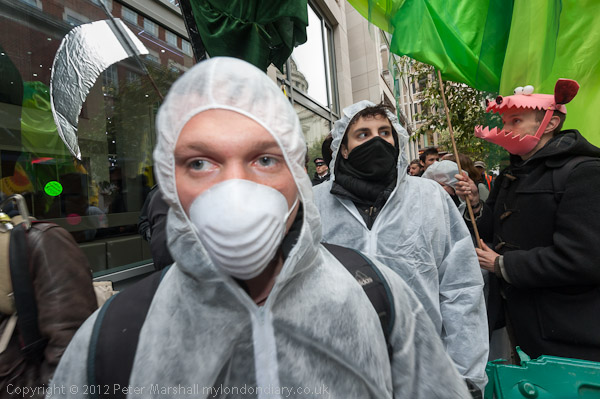
Protesters outside the summit hotel
more pictures
Protesters from the Climate Justice Collective marched in four blocs to the hotel where the UK Energy Summit was taking place and carried out a noisy protest in the street outside, eventually being kettled by police.
The protest was called by the Climate Justice Collective, a successor to the various Climate Camps, which describes itself as "a national network tackling corporate control, fuel poverty and climate change" and as being close to the Occupy Movement.
There were four blocs of protesters, each with a different meeting point, which converged on the Grange Hotel, just a few yards south of St Paul's Cathedral at around 11.30am, each with a sound system, banners and some appropriate dress.
The Robin Hood bloc focused on the energy monopoly of the Big Six energy providers - SSE, EDF, E.ON, Scottish Power, NPOWER and Centrica British Gas - which between them supply 99% of domestic energy in the UK, urging us to 'Take the power back' and put 'People before profit'. The Dirty Energy bloc concentrated on the highly polluting nature of the production and use of fossil fuels including fracking, tar sands, deep sea oil drilling and open cast coal, as well as the dangers of nuclear energy. The Housing bloc exposed the major factors that lead to fuel poverty, the profiteering of the energy companies and successive government's increasing privatisation of housing.
But the most striking of the four blocs, with its large (and small) dinosaurs and other was the family-friendly Fossil Free Futures bloc, including protesters from 0 to 90, with the aim of driving the Big Six Energy Dinosaurs into extinction and showing the "colour and creativity of the democratic, fair and clean alternatives to the prehistoric energy companies’ fuels and thinking."
I set out with around 50 protesters in the Dirty Energy bloc which met outside City Thameslink in light rain. Many of them put on white 'radiation suits' and masks and banners and placards remembered Fukushima and called for an end to nuclear power generation. Led by a sound system pulled by a bicycle the group made its way up the hill to St Paul's Churchyard where it met up with protesters from the Robin Hood and Housing blocs.
Together the three groups moved to the Grange Hotel, a modern building a few yards away, to find a group of police blocking the main entrance. The protesters turned down a side street and were again blocked at a second entrance, although a few almost managed to get in as staff struggled to close the door. They then tried to enter an alley further down the street, and police were quick to block there way again. There were a few scuffles as protesters tried to push their way past police, and then a more concerted effort that pushed the police back ten or fifteen yards into the alley, but police reinforcements soon arrived and pushed them out.
One protest appeared to have been injured when police knocked him to the ground, and he and another protester appeared to be arrested, but the situation was very confused. After a short time, protesters moved back to protest outside the well-guarded main entrance, where again there were a few attempts by protesters to push their way through the police lines, which were repelled forcefully, with police throwing protesters back into the crowd. I was hit by them a couple of times and knocked to the ground by a large protester thrown backwards by police. The protester was very apologetic, and fortunately my cameras were not damaged, and I was just a bit bruised.
Police drew their batons and threatened the crowd, but I didn't actually see any of the protesters being hit, though I was still a little stunned.
Minor incidents continued for a while, particularly as protesters tried to tape banners to the hotel wall and windows (something the police rather ludicrously describe as 'criminal damage.) Eventually the protesters moved away and around the corner into Peter's Hill, a rather more public area with tourists walking past from the Millennium Bridge up to St Paul's. After a short time there, police decided to close off the top of this to prevent them moving back to St Paul's Churchyard, which seemed pointless, and around a quarter of an hour later the police apparently agreed and removed their line.
People then drifted back to Godliman St and the Grange Hotel, and there was some chanting, singing and dancing there, as well as a few more minor disagreements as police continued to stop protesters putting their banners on the hotel wall and windows.
Around 1.30pm, for no apparent reason, a line of police vans drove in and blocked the top of Godliman St, and other officers advanced and blocked off Carter Lane and advanced up Godliman St to move protesters from the hotel entrance, kettling the roughly 250 protesters who were in the area. Some were standing around outside the kettle and more were apparently taking part in several workshops about energy issues elsewhere.
The protesters were continuing there protest inside the kettle outside the
hotel when I left around half an hour later, with some dancing to the sound
systems. Some of those who had been outside had made their way into the kettle
to join the protest, although police were refusing to allow people to leave.
more pictures
Stock Exchange Occupied
Paternoster Square, London. Tues 1 May 2012
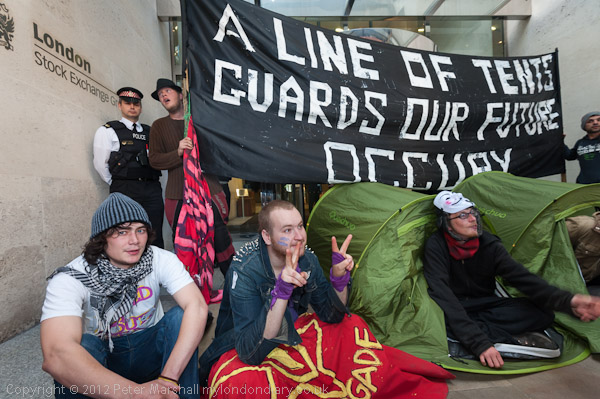 Tents
and banner 'A Line of Tents Guards our Future - Occupy' in the London Stock
Exchange entrance
Tents
and banner 'A Line of Tents Guards our Future - Occupy' in the London Stock
Exchange entrance
more pictures
Seven months after their unsuccesful bid to set up a camp at the London Stock Exchange, Occupy LSX this evening pitched two tents in the entrance to the building and occupied the square for around four hours.
Occupy London had been leading the police in a largely good-natured tour of Central London shops taking part in the workfare scheme, employing unpaid workers, including branches of Pizza Hut, McDonalds, Greggs and Holland and Barrett.
The protesters had managed to beat the police to a few shops, where they
had entered and shouted their protests and handing out leaflets before being
ejected by police with little or no resistance, but at most of the outlets
a few police had arrived before them and blocked the doorway.
Shortly after six pm, when the protest was in Strand, close to Charing Cross
Police Station, the police decided they had had enough and left. The protesters
marched down Strand for a brief protest outside the law courts and then headed
to the Stock Exchange. A van of City of London Police met them close to Ludgate
Circus, but then drove off.
There were no police visible as they came through Temple Bar and into Paternoster Square. The leading group posed for photographs around the monument in front of the Stock Exchange and then made their way to the entrance, which was locked by the security men on duty, but the protesters made no attempt to enter the building.
They immediately erected a token tent in the door way, and later a second one joined it. Others simply sat around and started to picnic.
A few police arrived and stood between the tents and the door. Later more came and stood watching from the square where people were beggining to party. One protester with an 'Anonymous' mask climbed up onto the monument, and police could see no immediate way to get him down. He was handed up a large maypole with a sign on it 'Reclaim Mayday' and a tent was thrown up to him which he erected and was still sitting up there when I left.
It was obvious from the start that this was a token occupation - there were
very few people with tents - and police simply cleared the doorway but seemed
to be letting the protest continue until the occupiers got fed up, or at least
waiting until they could get a cherrypicker to remove the man from the monument.
Later I read reports that they had been informed that the injunction against
them was still in force and had been ejected a little after 11pm.
more pictures
May Day Workfare Protest
Oxford St - Royal Courts of Justice, London. Tue 1 May 2012
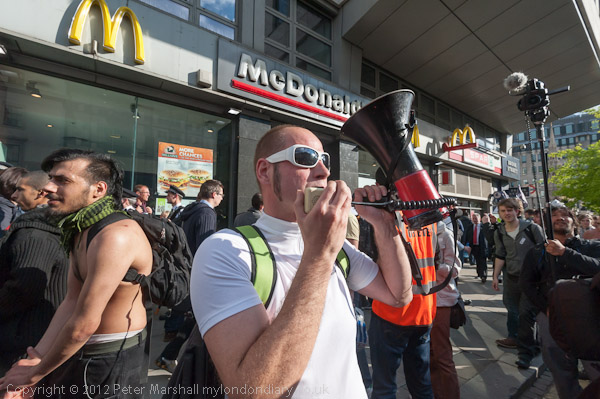
A largely good-natured crowd denounced workfare employers
outside their outlets in central London
more pictures
A crowd of several hundred people walked and ran around the West End after the end of the May Day Rally followed by a large group of police, protesting outside various branches of shops which take part in Workfare schemes.
The protest was organised by the London Solidarity Federations with support from Occupy London and also drew in some of the others from the May Day march. When I joined them around an hour after the protest had started they were on Oxford St, and we stopped briefly outside several shops including Pizza Hut, Holland and Barratt and McDonalds. There was a banner reading 'Workfare is Stealing Your Jobs' and people chanted slogans including 'We Won't Work for JSA.' Many unemployed people have been told that unless they take up workfare placements in which they get no pay for full-time work they will lose their Job Seekers Allowance.
Under workfare the employer gets a worker for nothing, saving them having to employ someone to do the work - so there is one less job for every person in the scheme. In this respect it is very different to work experience schemes. Almost all the jobs involved are relatively unskilled work that involves no training and so make little contribution to the development of those undertaking them. The protesters seem them as just a way of providing forced free labour.
While I was present few protesters actually entered any of the shops, even when they arrived before the police (who seemed rather less fit than the average protester.) In the few places where they did the protesters simply shouted their slogans or handed out leaflets and left when asked by the police.
In many ways it seemed like some kind of match between the two teams - police and protesters - with a fair amount of largely good-natured banter, along with a little more serious argument. Later I read reports that a couple of arrests had been made before I arrived and that one woman had been knocked to the ground by a woman officer.
The protest moved along and down the Charing Cross Road and on to the Strand as far as Somerset House before turning back and up into the side streets of Covent Garden before taking a wrong turning and rushing back down to the Strand. It called in briefly to the steps of Charing Cross Police Station then back to Top Shop.
At this point the police disappeared - leaving a surprised crowd of protesters
wondering what to do. Many of them, led by the people from Occupy London,
decided to head for the City, led by the 'Reclaim May Day' maypole,
stopping on the way for a very short protest at the Royal Courts of Justice
where they briefly displayed a banner on the railings reading 'Vote None
of the Above' for Thursday's elections.
more pictures
Abolish The Corrupt IPCC
High Holborn, London. Tue 1 May 2012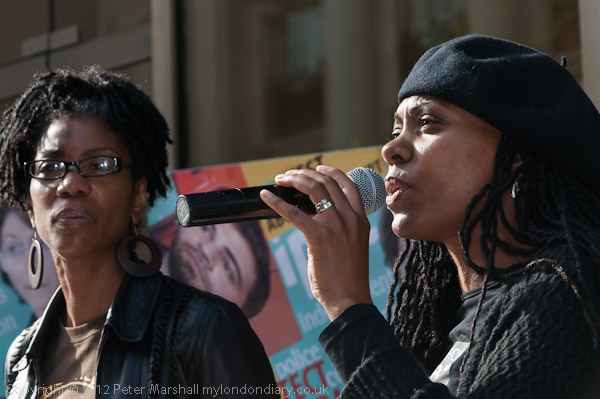
Samantha Rigg speaks, Marcia listens as she talks about
the failure of the IPCC over their brother's killing
more pictures
Campaigners led by Campaign4Justice and Merlin Emmanuel called for the replacement of the IPCC which is dominated by former police officers by a citizen-led body that has proper powers and true independence from the police.
More than a hundred people came to the protest outside the IPCC offices in Holborn where a series of speakers related the failure of the IPCC to deal with their cases.
When I arrived a spokesperson was speaking about the case of Hollie Greig, a young girl with Down's Syndrome subjected to long-term sexual abuse by leading members of Aberdeen society. The Scottish police have failed to properly investigate the case and have collaborated with the English police in further harassment of Hollie's mother and supporters.
Among those present at the protest were Ali Dizaei, and the key witness against him in his recent trail was alleged to have been protected by the police and the IPCC against allegations of rape. There were a number of supporters of the victim of the alleged rape at the protest with posters calling for the abolition of the IPCC.
Organisers of the event, Michael Doherty, of the Campaign 4 Justice and Merlin Emmanuel, Smiley Culture's nephew also spoke about the corruption of the IPCC which was set up to replace the previous corrupt Police Complaints Authority. Although the IPCC was intended to be independent, more than a third of its employees are said to be former police officers and the organisation is dominated by the interests and attitudes of the police service.
Perhaps the most powerful speech and a powerful indictment of the IPCC came from Tottenham Community Activist and race relations consultant Stafford Scott, who has been involved with community relations with the police since the Broadwater Farm incident. He laid blame at their door for the summer riots, with the IPCC colluding with the police to issue deliberately false information to the public. Lee Jasper also gave a forceful speech.
Sean Rigg's sisters Marcia and Samantha both spoke about the many failures of the IPCC in the investigation of Sean's death in Brixton Police Station, where the family's own investigations revealed far more than the ineffectual work of the IPCC. Both were inhibited in what they could say by the forthcoming inquiry due to start next month.
The IPCC itself has called to be given increased powers after it found it
was unable to interview any of the 31 officers who was present at the fatal
shooting of Mark Duggan in Tottenham. After the protest Commons Home Affairs
Committee chairman Keith Vaz confirmed that they intend to hold an inquiry
into the powers and future of the IPCC.
more pictures
London May Day March
Clerkenwell Green to Trafalgar Square, London. Tues 1 May 2012
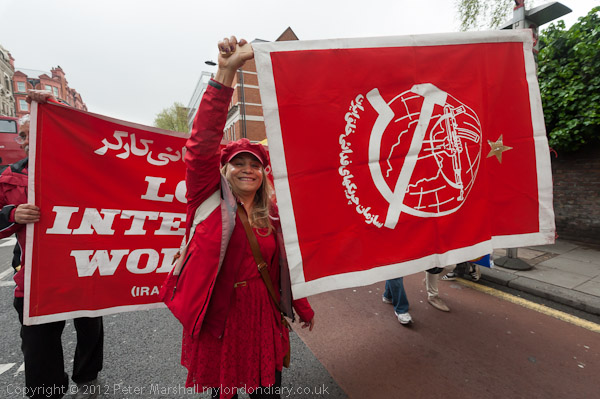 Supporters
of the Iranian freedom fighters on the May Day march
Supporters
of the Iranian freedom fighters on the May Day march
more pictures
The London May Day march has taken place every 1 May since the 1970s, and has been a part of a continuing campaign for May Day to be a public holiday. May Day itself has been celebrated in London since the 1880s.
The march brings together "trade unionists, workers from the many international communities in London, pensioners, anti-globalisation organisations, students, political bodies and many others in a show of working class unity" and since 2002 has got the use of Trafalgar Square for a rally.
Among the various key issues for workers raised by this year's march were the attacks on pensions and other cuts, the closure of one third of Remploy factories with the loss of jobs by more than 1500 disabled people, and the workfare scheme which is being used to compel the unemployed to give free labour to companies or lose their job-seekers allowance, leading to less paid jobs being available.
The issue of workfare was taken up by the several hundred in the autonomous block at the rear of the march, many of whom were wearing black clothing and some wore masks. They stopped to protest on the Strand outside some of the shops using free labour or avoiding paying taxes, including branches of McDonalds, Greggs, Topshop and Pizza Hut. There were a few minor scuffles when police grabbed some of the more vocal protesters and dragged them behind police lines, with some being handled roughly, pushed to the ground and having their wrists tied behind their backs.
In Trafalgar Square there were also some minor arguments when police forced
Occupy protesters who had erected a couple of tents to take them up.
more pictures
top of page
All pictures on this section of the site are Copyright © Peter Marshall 2012; to buy prints or for permission to reproduce pictures or to comment on this site, or for any other questions, contact me.

